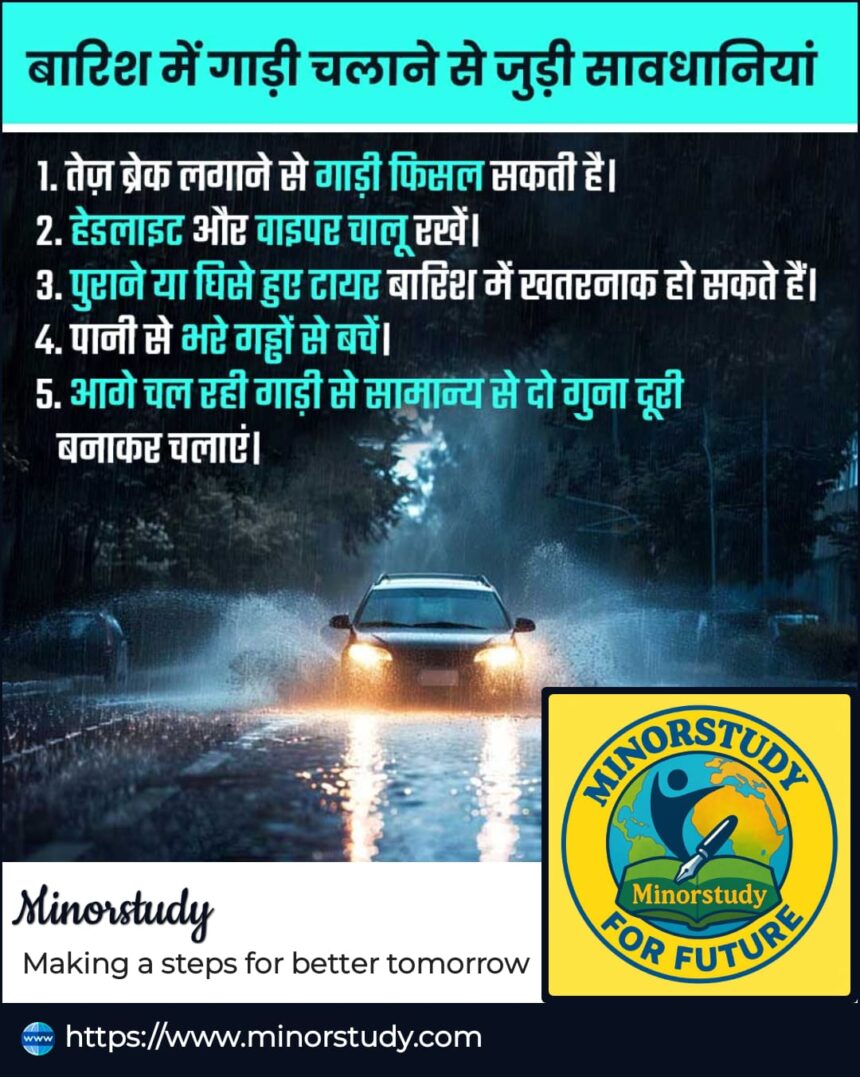7 Powerful Rainy Day Driving Tips That Could Save Your Life – Avoid These Deadly Mistakes
Driving: Rain can bring relief to the earth, but it also brings hidden dangers for drivers. Every year, thousands of accidents occur during the rainy season due to poor visibility, slippery roads, and negligent behavior. Whether you’re a seasoned driver or just starting out, driving in the rain demands extra caution and awareness.
- 🚗 History: Why Rainy Season Driving Safety Became a Global Concern
- 📅 Timeline of Awareness and Precaution Measures
- ✅ 7 Powerful Safety Tips for Driving in the Rain
- 1. Avoid Applying Sudden or Hard Brakes
- 2. Keep Headlights and Wipers On – Always
- 3. Replace Old or Worn-Out Tyres
- 4. Avoid Water-Filled Pits
- 5. Double the Distance from the Vehicle Ahead
- 6. Avoid Cruise Control in Wet Conditions
- 7. Stay Calm & Informed
- ❓ FAQs: Driving in the Rain
- Q1: Is it safe to drive during heavy rainfall?
- Q2: Should I deflate tyres for better grip?
- Q3: What should I do if my car hydroplanes?
- Q4: Are fog lights necessary in the rain?
- Q5: Is it safe to drive two-wheelers during rain?
- 🎯 Significance: Why Monsoon Safety Is Vital
- 🎉 Wishing: Stay Safe, Stay Alive
- 📌 Important Points Recap
- 🌧️ Observance in Society
- 🌱 Daily Life Impact
- 🧘 Conclusion: Your Life is Precious. Drive Like It Is.
This article dives into the importance of driving safely in the rain, backed by facts, a human-friendly perspective, frequently asked questions, historical context, and timely life-saving advice. Read on to discover why rain and recklessness don’t mix—and how you can avoid fatal mistakes.
🚗 History: Why Rainy Season Driving Safety Became a Global Concern
Rain-related accidents have been a topic of public safety concern for decades. According to World Health Organization (WHO) and Indian Road Safety reports, wet road conditions increase the risk of accidents by over 30–40%. Most of these accidents happen due to:
Poor braking control
Reduced visibility
Hydroplaning (loss of traction due to water)
Lack of awareness about safe practices
Governments around the world, especially in monsoon-prone countries like India, Indonesia, and Thailand, now run seasonal campaigns urging drivers to follow monsoon safety rules.
📅 Timeline of Awareness and Precaution Measures
| Year | Event |
|---|---|
| 1990s | First public road safety campaigns on monsoon driving in India |
| 2005 | WHO includes monsoon-related road fatalities in Global Status Report |
| 2010 | Introduction of ABS (Anti-lock Braking System) made mandatory in many countries |
| 2020 | India launches “Rain Ready Roads” and awareness drives in cities |
| 2024 | Digital road condition updates and monsoon alerts via apps become common |
✅ 7 Powerful Safety Tips for Driving in the Rain
1. Avoid Applying Sudden or Hard Brakes
Slippery roads mean less traction. Applying sudden brakes may cause your vehicle to skid uncontrollably. Instead:
Brake gently and gradually
Drive in lower gears
Keep your foot lightly on the brake in slow traffic to dry brake pads
2. Keep Headlights and Wipers On – Always
Rain reduces visibility for both you and other drivers.
Use low beam headlights – never high beams in rain
Wipers should be clean and functional
Consider anti-fog treatments for the windshield
3. Replace Old or Worn-Out Tyres
Bald tyres can be deadly in rain, increasing the chance of hydroplaning.
Maintain proper tread depth
Check air pressure regularly
Use rain-friendly tyres if you live in a monsoon-prone area
4. Avoid Water-Filled Pits
Potholes or waterlogged roads can hide deep craters or open drains.
Drive slowly through puddles
Never enter water if unsure of its depth
Avoid roads where sewage overflows or drains are visible
5. Double the Distance from the Vehicle Ahead
In dry conditions, the safe distance is often one vehicle length. In rain, increase that to two lengths or more.
Gives you extra time to react
Prevents rear-end collisions
Important for larger vehicles and trucks
6. Avoid Cruise Control in Wet Conditions
Modern vehicles with cruise control may accelerate unexpectedly on wet surfaces.
Manually control speed
Stay alert to changes in road surface
Use gear braking if possible
7. Stay Calm & Informed
Listen to traffic advisories, use Google Maps live traffic, and don’t panic if the car skids.
Steer in the direction of the skid (counter-steering causes spinouts)
Never brake suddenly
Stay home if rains are extreme
❓ FAQs: Driving in the Rain
Q1: Is it safe to drive during heavy rainfall?
Only if visibility is clear, your car is road-ready, and you maintain slow speed. Avoid during red alerts or flood warnings.
Q2: Should I deflate tyres for better grip?
No, that’s a myth. Follow the manufacturer’s pressure recommendation. Deflating tyres reduces control.
Q3: What should I do if my car hydroplanes?
Lift your foot off the accelerator, don’t brake, and gently steer in the direction you want to go.
Q4: Are fog lights necessary in the rain?
Only during very heavy fog or mist. For rain, low beam headlights are more effective.
Q5: Is it safe to drive two-wheelers during rain?
Cautiously, yes. Wear a helmet with a clear visor, avoid waterlogged routes, and go slower than usual.
🎯 Significance: Why Monsoon Safety Is Vital
India sees over 1.5 lakh road deaths annually; a significant percentage occurs during the monsoon.
It’s not just about saving your own life, but also protecting pedestrians, cyclists, and fellow drivers.
Monsoon-related accidents often lead to life-long injuries, affecting productivity, families, and emotional wellbeing.
🎉 Wishing: Stay Safe, Stay Alive
“This monsoon, let your family not wait in worry—drive safe, slow, and smart.”
“May the rains bring joy, not tears. Wishing you and your loved ones a safe and blissful rainy season.”
📌 Important Points Recap
Brake gently, not suddenly
Keep headlights and wipers ON
Replace worn tyres
Avoid flooded roads
Double your distance from the car ahead
Never use cruise control
Keep calm and stay informed
🌧️ Observance in Society
Schools and workplaces now teach monsoon safety drills
Auto shops offer pre-monsoon vehicle check-ups
Authorities put up “Drive Slow When Wet” signs
Driving schools now include rain training modules
🌱 Daily Life Impact
Incorporating these practices can:
Prevent accidents and financial losses
Reduce insurance claims and premiums
Build a safety-first driving culture
Ensure peace of mind during travel
More than a checklist, these are habits of responsible citizens—ones that could save lives and prevent lifelong regrets.
🧘 Conclusion: Your Life is Precious. Drive Like It Is.
Rain is a blessing—but it demands respect on the road. The sound of raindrops shouldn’t be followed by the sound of sirens. Driving safe in the rain is not just a choice—it’s a moral responsibility.
So the next time you grip the steering wheel under a grey sky, remember these words:
“Your family waits for you—not your speed.”








